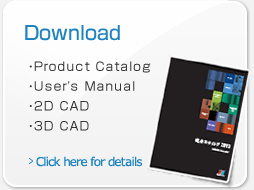The Production Method of Metal Components
The three types of production methods of metal components are: Removal processing, additional processing and deformation processing.
Removal Processing
Removal processing is the process of acquiring a shape by removing a portion of material by shaving and sharpening.
Cut Processing
We primarily we use 3 types of machine tools for metal processing.
The Lathe
Processing with a lathe machine tool is known as “lathing”.
This processing removes material from a rotating material, the tool does not rotate.
The Milling Machine
Processing with a milling machine tool is known as “milling”. As explained before, lathing does not involve rotation of the tools. The milling process rotates several cutting-edge tools at high speeds to cut flat surfaces.
The Drilling Machine
Processing with a drilling machine tool is known as “drilling “. It is also known as “reaming”.
After “drilling” a hole using a drill, the process of “reaming” utilizes a reamer to expand the size of the hole or make finishing touches to the hole made by drilling.
Grinding
Grinding is the process of shaving the surface of material by using the hard, abrasive particles of a whetstone. Recently, there is a demand for a high degree of accuracy in dimensional precision and surface roughness. The grinding process is required after the cutting process has been completed. For surface roughness adjustment, polishing may also be carried out after grinding.
The Grinding Machine
There are a number of types of grinding machines that are used for different machines according to the required processing features. If you want to increase the “flatness” of a surface, you use a surface grinding machine. If you want to increase the “roundness” or “cylindricality” of a surface, you use a cylindrical grinding machine. If you need to grind the interior of a hole, an internal grinding machine is used.
Additional Processing
Additional processing is used to acquire additional surface properties using adhesive materials and other processing methods.
Welding
Welding is the process of joining and integrating two or more separate materials by applying heat and pressure.
The most commonly used welding methods are listed below:
- ・Arc Welding
- ・Gas Welding
- ・TIG Welding
- ・Brazing
Arc Welding
Arc welding is a welding method that utilizes an electric arc. By creating an electric arc between the welding rod and the materials, the welding rod melts to form a joint between the materials.
Gas Welding
Gas welding involves using a gas welder to generate heat from gas to join the base material and welding rod via melting.
Compared to arc welding, the welding time is longer and the surface area of the welding range also increases due to the decrease in welding strength.
TIG Welding
TIG welding is short for Tungsten Inert Gas welding. This welding process uses a gas welder to melt the material and welding rod as a result of the heat of the gas.
TIG welding takes longer when compared to arc welding. With TIG welding, the surface area of welding increases while the welding strength decreases. However, the finish has a beautiful appearance.
Brazing
Brazing does not involve the melting of the material. It is done by melting the filler which has a lower melting point than that of the material. This is then poured into the joint to join two materials. Because it doesn’t melt the material, the welding strength is weaker than other welding methods. However, brazing is best suited for precision joining.
Pressure Welding
Pressure welding is done by applying mechanical pressure to the material to create a joint.
Friction Pressure Welding
Friction welding is done by rubbing the metals you want to join against each other at high speeds. This causes friction and heat which create mollification between the two materials. At the same time, pressure is also applied to create a joint.
Friction pressure welding makes difficult welding situations such as joining aluminum and stainless steel or copper and aluminum possible. Unlike conventional welding processes, there is no gas or sputter involved. Thus, friction pressure welding is said to be good for the environment.
The Deformation Process
The deformation process is the process of deforming a material to acquire a certain shape.
Casting
Casting is a production method which involves the pouring of melted metals like iron, aluminum or copper into a mold to create a product.
Currently, automobile tire wheels, engines, valves, and manholes are made by the metal casting method.
For casting processes, many types of molds are used depending on the desired outcome.
- ・Sand casting
- ・Metal mold casting
- ・Die-cast
- ・Lost-wax
Die-cast
Die-cast (or die casting) is a type of metal mold casting in which you apply pressure and pour the melted metal into the mold. This results in high dimensional precision and a very smooth surface area of the finished product.
It is the typical casting method utilized when using aluminum, magnesium or zinc as an injection material.
Lost-wax
Lost-wax casting, meaning losing wax, is a casting method that uses the relatively low temperature of wax.
By shaving the wax, the original form is created. Then, the form is hardened by surrounding it with foundry sand. The wax is then melted away to create a cavity. Melted metal is then poured into the created cavity.
The Forging Cast Process
The forging cast process involves hitting the metal to achieve the desired outcome. First, the metal is softened by heating and then deformed by hitting it with the hammer to the desired shape or objective.
Hot forging and Cold forging
Hot forging is a type of forging achieved by applying heat. Cold forging is a type of forging performed at room temperature.
Molds that use hot forging have the advantage of producing products with high durability. Molds that use cold forging have the advantage of producing products with high dimensional precision.
The Metal Press Method
The Metal press method involves the sandwiching of metal materials with paired tools while force is applied so that the metal will deform into the shape of the tool.
The metal processing method contains processes known as “Punching” and “Stamping”
Punching
Punching requires a tool with a hole (convex shape) and a tool with a 5~10% thickness gap (concave shape) of the material. These tools are used to punch portions out of the material. To punch out a thin material you need a tool with high precision and to punch out a thick material you need a strong tool that can withstand the specific gravity.
Stamping
The stamping process requires specific tools such as a punch and dice. This process creates a container shaped product from a plate material. Depending on the container a cylindrical stamp and square tube stamp are available. The cylindrical stamp holds the surroundings of the cylindrical plate and is pressed down to the center of the plate.
The square tube stamp is more difficult to process.
The Powder Metallurgy Method
The powder metallurgy method is a technology that involves the compressing of powdered metal and then sintering at high temperature to create components with high accuracy. Using materials like iron, copper and nickel, raw material powdered metals are created and put into a pattern mold, and compressed with a press machine to create a molded product.
MIM (Metal Injection Molding Method)
The MIM method is done using injection molding machines which are used in making plastic products. By pouring the melted powder metal at a high temperature into a pattern mold, and cooling for a period of time, a mold can be created.
The Cycle of Metal Component Manufacturing
After processing material, to create “the material process”, you then finish it with machine processing precision. This completes the creation process of the metal component.
In other words, the deformation process explained earlier is a “Material process”.
The material processing industry is a very important industry for supporting Japan’s manufacturing industry. Needless to say, the quality, performance, production volume and production value of Japan’s material processing industry is the first rate within the world.
 日本語
日本語 English
English Deutsch
Deutsch 中文
中文 한국어
한국어






